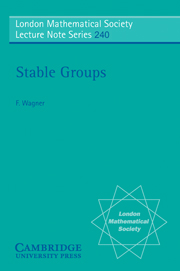4 - Groups & Geometry
Published online by Cambridge University Press: 05 April 2013
Summary
In this chapter, we shall analyse the dependence relation associated with forking. After some remarks in section 0 about geometries and pre-geometries in general and the geometry of forking in particular, we add additional conditions on the family P of types whose forking geometry we want to study. In sections 1 and 2 this is local modularity; put crudely, a locally modular theory should essentially behave either like a set with no structure (the trivial case), or like a module over some ring. In section 1 the general theory of local modularity is developed, and it is then applied to groups in section 2: if the generic type of a group is locally modular, then the group is abelianby-finite; if the generic type is analysable in a locally modular family P of types, then the P-connected component of the group is nilpotent. In the case where the generic type of a group is locally modular and regular, we shall show that the module structure is actually present: generically the group behaves like a vector space over a certain division ring, namely the ring of quasi-endomorphisms. A particular case of local modularity is one-basedness; we shall show that a group is one-based iff it is an abelian structure.
Section 3 introduces an important tool in obtaining a definable group from structural considerations, the group configuration. We shall show in particular that a locally modular non-trivial family P of types gives rise to a type-definable P-semi-regular group acting faithfully and transitively on some set X, and we classify the possibilities for that action in the case Up(X) = 1. In particular, every locally modular regular type is either trivial (and so its forking geometry is uninteresting) or equivalent to the generic type of a group (and we may apply the results of the preceding section).
- Type
- Chapter
- Information
- Stable Groups , pp. 188 - 249Publisher: Cambridge University PressPrint publication year: 1997

